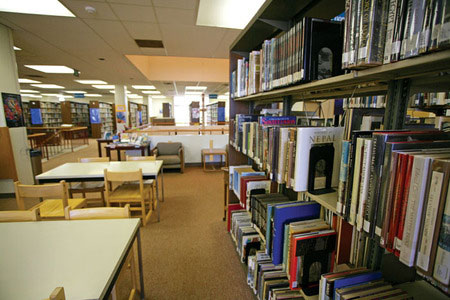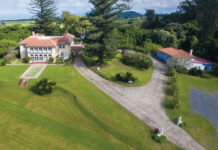Story by Jill Engledow | Photography by Jason Moore | Illustration by Guy Junker
 Maui County needs nurses, teachers, social workers, high-tech mavens, and savvy businesspeople. Maui has a beautiful community-college campus with talented and dedicated faculty and distance-learning facilities that reach students in the county’s most isolated areas.
Maui County needs nurses, teachers, social workers, high-tech mavens, and savvy businesspeople. Maui has a beautiful community-college campus with talented and dedicated faculty and distance-learning facilities that reach students in the county’s most isolated areas.
But the school’s courses lead only to a two-year associate’s degree, so most potential professionals must leave the island to obtain a bachelor’s degree. The obvious move, some say, is to turn Maui Community College into a four-year college.
Perhaps the hottest topic on campus in recent years, the four-year-college proposal has been batted around for decades.
“Every Maui mayor since Hannibal Tavares has shared the vision and goal of a four-year college built here,” Mayor Alan Arakawa said in his State of the County address in January. “Without education, neither we nor our children will be able to compete in this new century. . . . That’s why my administration fully supports the development of a four-year institution of higher learning—the University of Hawai‘i at Maui.” The mayor backed up his words by requesting $2 million in the 2007 county budget, partly to help begin the transition to a four-year school.
Statistics collected by the Maui High School counseling office also indicate a demand for four-year education. Of that school’s graduates, 47 percent enroll in four-year institutions. But while there are many compelling arguments for increasing opportunities for higher education on Maui, establishing a four-year college is easier said than done. It is, in fact, an extremely complex undertaking.
Even MCC Chancellor Clyde Sakamoto, a leading proponent of a four-year campus for Maui, acknowledges a primary concern: to “be sure, before we expand, we shore up what we have.”
During Sakamoto’s tenure, MCC has received $111 million in construction appropriations, for which the chancellor credits a team effort by legislators past and present. But while those sums made possible a handful of handsome and spacious new buildings, the State hasn’t provided the funds to maintain them; what gets broken stays broken.
And with annual electricity costs of nearly $1 million (which last spring forced the college to reduce library hours and leave needed faculty and clerical positions unfilled), and frustrated students unable to find space in basic core classes, the question is whether an already cash-strapped MCC can find reliable resources to open and maintain a four-year school.
While a faculty committee debates this question, one MCC-based University of Hawai‘i program, the University Center, continues to “broker” four-year and graduate-degree programs from other UH campuses through on-line classes and interactive TV—graduating more than 500 people on Maui since 1997. And last fall, MCC became the first Hawai‘i community college to offer a four-year baccalaureate (in applied business and information technology, or ABIT), dipping a careful toe into the uncertain waters of four-year accreditation.
Sakamoto’s vision is for the college “to focus on applied sciences at the baccalaureate level that can address the thorny ecological, economic, and sociological problems facing Maui County. Sustainability for our island community is especially important with escalating energy, housing, food, gas, and health-care costs.” And with the island’s already formidable cost of living, Mauians need to be able to move into the kinds of high-paying careers that are becoming available here—careers that require a bachelor’s degree or better.
MCC Academic Senate Chair Daniel Kruse points out that citizens participating in the Focus Maui Nui process (which brought together 1,700 Maui residents in 2003 to discuss their vision for the future) named improved education as their number-one priority. Economic development was priority number four. Creating a “college town” has a lot of potential economic benefit, Kruse says.
The University of Hawai‘i has certainly had a positive effect on the economy. A 1997 study by economics professor Dr. David Hammes, who teaches at the university’s Big Island campus, placed UH–Hilo’s impact at $90 million a year. Hammes estimates that the figure is now around $190 million, with inflation accounting for about a third of the increase, two-thirds in real economic growth.
Studies conducted in 2000 and 2003, concluded that the UH system is “a major economic sector in Hawai‘i.” “Indeed,” the 2000 study noted, “one can think of the UH system as if it were one of many businesses or industries in Hawai‘i. It produces education and research services as its primary outputs. In addition, it produces entertainment and sports services, consulting services, health care, housing and food services.”
Less tangible, but real, are the benefits of having a home-educated workforce who will tend to stay in the area and contribute their skills to the community.
Sakamoto and Kruse also stress the value of attracting nonresident students, who pay tuition rates four to five times higher than residents, and who “bring the world” to Maui classmates who might never stray far from their home island. “Our local kids here could be part of an international network” developed through college friendships, says Sakamoto.
One key component of attracting off-island students, a new 400-bed housing facility, will begin to accept students as early as this year. But nonresident students, especially those who don’t speak English well, will need other kinds of support to integrate into the campus. And some faculty members fret that, while more international students would be great, the needs of hometown students should not be sacrificed to attract them. Still, as Dr. Hammes points out, local students might want to stay at the home institution if they think that others want to come here, and that improving the institution to attract outside students makes the home institution a better place for all.
Expanding while meeting current needs, Kruse says, “is the big balancing act.” The speed of adding degree programs to the campus depends in large part on the resources available from the State and, to a lesser extent, the County.
Though Mayor Arakawa’s proposed 2007 budget included $2 million for the college, the County Council, concerned about committing to an ongoing project at an educational institution that is a State responsibility, approved only $500,000. The council required that the State provide matching funds and earmarked the money for expansion of the nursing and dental-care programs.
The County has helped fund MCC programs in past years, recognizing that the college is an important part of the community and its economic development. And the Legislature was generous, in what has been a good year for the state budget, promising the college a minimum of $2.5 million in operational funding to be added to its ongoing annual budget.
The first year’s funding included $988,000 for next year’s electric bill, while the governor released $742,000 at the end of the spring semester to help catch up with last year’s power costs. The additional operational funding for the next school year also will pay for other needs ranging from faculty to custodial positions.
But while the Legislature has said this operational infusion will be ongoing, much funding, such as federal grants Sakamoto has been able to bring in for special programs, is “soft” money, says longtime English professor and campus leader Vinnie Linares. To go to the four-year level, there must be “hard” money, reliable funding that can be counted on year after year—“millions of dollars of foundational support.”
Like others who worry about the existing financial problems, Linares says MCC now is “understaffed, underbudgeted. Things are falling apart. There’s no maintenance.” Money that comes in often is earmarked for particular programs such as nursing or culinary arts, leaving the required 100-level courses short of funds—not to mention the counseling, tutoring, and remedial classes many students need before they can handle college-level work.
MCC’s faculty wants access to four-year degrees for its students. Around the country, community-college baccalaureates are increasing, according to the American Association of State Colleges and Universities, because of demands like those on Maui: nontraditional students who are time- and place-bound, the need for more graduates in specialized areas such as health care and education, and new kinds of baccalaureate degrees in applied and technical fields.
Unfortunately, “it’s not as easy as any of us thought it would be,” says Elaine Yamashita, associate professor of human services.
Accreditation for four-year and two-year colleges is handled by different commissions. Under the junior commission, which accredits community colleges, a school may add a single bachelor’s program, but with more than one degree it comes under senior commission accreditation, and that would mean meeting different and more demanding standards for faculty and infrastructure.
Yamashita is convening an Academic Senate ad hoc committee on baccalaureate degrees to look in detail at the kinds of resources that are needed, and to figure out how to navigate the accreditation system, which now recognizes the college’s new ABIT bachelor’s degree program as a “candidate for accreditation.”
There’s not been much precedent for these degrees in the Western Association of Schools and Colleges, which accredits schools in California and the Pacific, says Kruse. With its new four-year program, MCC now straddles the divide between the association’s junior and senior commissions. It’s tricky for a school to be a hapa or hybrid college, providing bachelor’s degrees as well as the associate degrees and vocational offerings of a community college.
A four-year institution also requires better library services (actually more important than ever in the age of the Internet, says Linares), and a science building far superior to the current one, still home to equipment that was in use when science professor John Pye started teaching at MCC 24 years ago.
Pye has been working with consultants to develop educational specifications for the new science building, a priority for the campus. The planners are going for a “green” design with maximum energy efficiency, but that sort of building requires higher upfront costs—perhaps as much as $30 million—that might be hard to get from the Legislature.
Still, “this is a science technology building; it should represent state-of-the-art. We should be setting an example,” Pye says. Legislators have visited the old building and know that “we are in dire straits. You can have all these great ideas for growth, but without infrastructure, you are going nowhere.”
“It’s inevitable that MCC is going to be a four-year school,” Linares says. “Maui is the most vibrant community in the state,” and there are political and economic forces pushing for the four-year college. “I think it’s a wonderful idea, if we can afford it,” he says, “and if the things that are struggling to survive are properly supported.”
To view the study “Economic Impact of the University of Hawai‘i,”
visit www.hawaii.edu/ovppp/inter/interecon830.html
For information on the UH Foundation, Maui, call Cordy MacLaughlin: (808) 984-3471.





